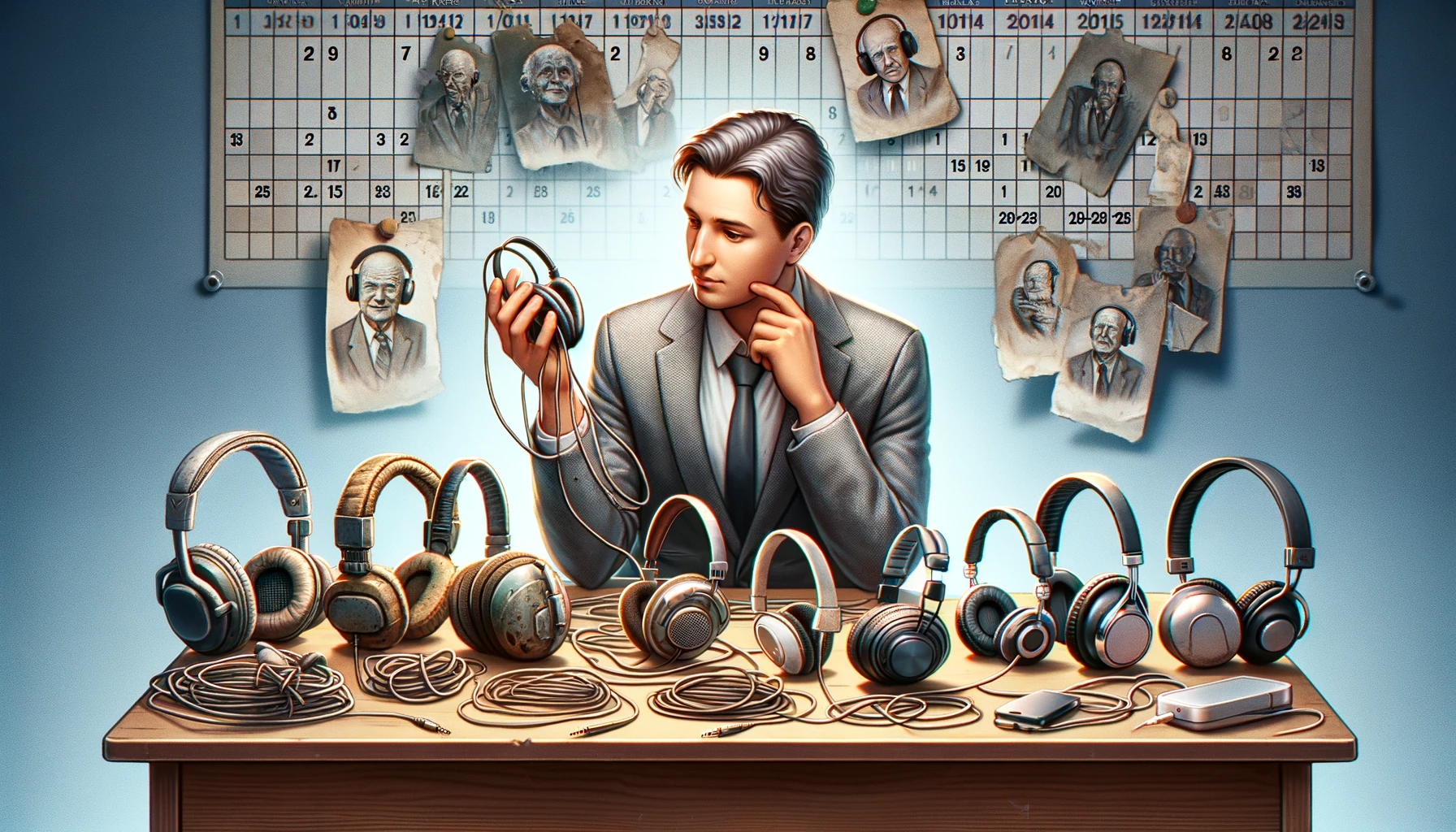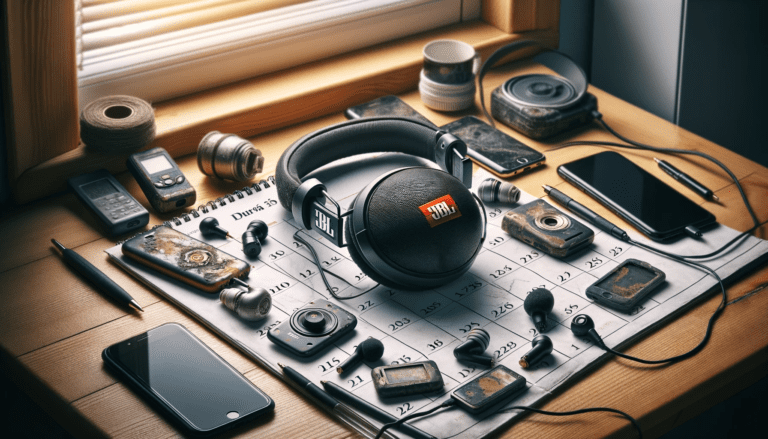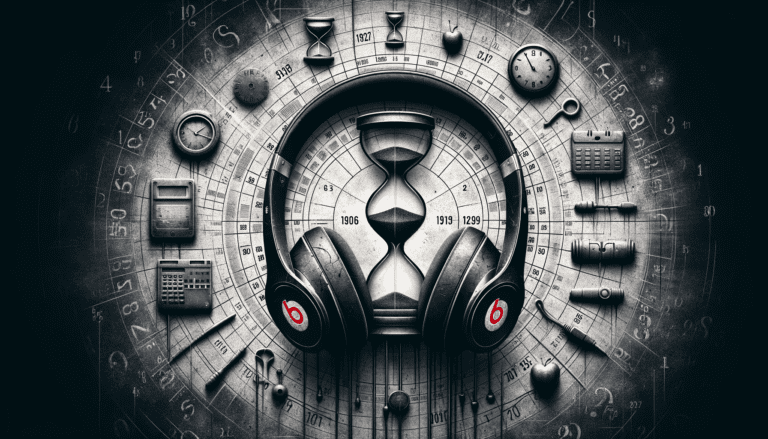Ever wondered, “How long do headphones last?” It’s a question that echoes in the minds of audiophiles and casual listeners alike. Quality, usage, and care all play pivotal roles in the lifespan of your favorite auditory companion. But what’s the real story behind those beats?
Generally, headphones last between 3 to 5 years with regular use. However, this duration can extend significantly with high-end models and diligent care, or shorten with rough handling and frequent usage. This article delves into the specifics, examining how different brands and types stack up in the longevity stakes.
But understanding the lifespan is just the beginning. Dive deeper with us as we explore tips to prolong your headphones’ life and recognize the telltale signs it’s time for a replacement. Join us on this auditory journey, and let’s discover how to make every beat count for as long as possible. Your ultimate guide to headphone longevity awaits!
Importance of headphones in our daily lives
Headphones have seamlessly woven themselves into the fabric of our modern lifestyles. They provide us with an escape from the mundane routines and offer a private sanctuary where we can fully immerse ourselves in soundscapes and melodies.
For music enthusiasts, headphones are essential tools to appreciate sonic nuances and experience every beat and note as intended by the artist. In addition to their role in entertainment, headphones have also become invaluable for communication.
In today’s era of video calls and virtual meetings, reliable headphones with clear microphones enable seamless conversations without any distractions or disturbances. They have become an essential accessory for professionals working remotely or participating in online conferences.
Curiosity about the lifespan of headphones
Naturally, we all wonder how long these little wonders will stay by our side before bidding farewell. The lifespan of headphones can vary significantly depending on various factors such as build quality, frequency and intensity of use, and maintenance habits.
Understanding these factors will not only help us make informed purchasing decisions but also ensure that we extend the lifespan of our beloved audio companions. In this comprehensive guide, we will delve deeper into what influences headphone longevity.
We’ll explore the impact of build quality materials like plastic, metal or wood; discuss how frequency and intensity of use affect their lifespan; and uncover maintenance tips that will keep your cherished pair alive for as long as possible. So, if you’ve ever wondered about the lifespan of headphones and how to make them last longer, read on!
Factors Influencing Headphone Lifespan
Build Quality and Materials
When it comes to headphone lifespan, the build quality and materials used play a significant role. The materials used in manufacturing headphones can vary from plastic to metal to wood.
Plastic headphones are generally more affordable but may not be as durable as their counterparts. Metal headphones, on the other hand, offer better longevity due to their sturdy construction.
Wood, although less common, can provide a unique aesthetic appeal but may require extra care. Moreover, the durability of hinges, headbands, and cables is crucial in determining how long your headphones will last.
Hinges that connect different parts of the headphones should be well-built and resistant to frequent opening and closing. A weak hinge can result in loose connections or even breakage over time.
The headband should be comfortable yet robust enough to withstand regular adjustments without losing its shape or structural integrity. Cables are another vital component that affects headphone lifespan.
High-quality cables with reinforced insulation can resist bending and twisting better than cheaper alternatives. Look for durable cables that won’t easily fray or break with everyday use.
Frequency and Intensity of Use
The frequency and intensity of use directly impact how long your headphones will last. If you’re a heavy user who wears their headphones for several hours every day, they might not last as long compared to someone who uses them sparingly. Additionally, the volume levels at which you typically listen to music or other audio also affects speaker components’ longevity.
Listening at excessively high volumes for extended periods can strain speaker drivers and lead to premature wear or even damage them permanently. To extend your headphone’s lifespan under heavy usage conditions, it’s recommended to take short breaks between listening sessions and avoid consistently playing audio at maximum volume levels.
Maintenance and Care Habits
Proper maintenance practices significantly contribute to the overall lifespan of headphones. Regularly cleaning your headphones is essential to prevent dust and debris buildup that can clog the speaker drivers and affect sound quality.
You can use a soft cloth or a small brush to gently remove any visible dirt or particles. Another crucial aspect of headphone care is proper storage.
Avoid throwing your headphones around or stuffing them in cramped spaces, as this can lead to cable tangling or physical damage. Consider investing in headphone cases or using cable management techniques like coiling the cable neatly when not in use.
By maintaining good care habits, you can significantly prolong the lifespan of your headphones and preserve their performance for years to come. Various factors influence how long headphones last.
The build quality and materials used, such as plastic, metal, or wood, impact durability differently. Additionally, the frequency and intensity of use play a role in determining longevity—heavy usage combined with high volume levels can accelerate wear and tear.
Proper maintenance practices like regular cleaning and careful storage also contribute significantly to extending headphone lifespan. By understanding these factors and adopting good habits, you can make the most out of your beloved audio companions for an extended period before needing replacements.
In-Ear Headphones (Earbuds)
When it comes to in-ear headphones, commonly known as earbuds, their lifespan is heavily influenced by the condition of their cables and ear tips. Since these headphones are small and portable, they tend to face more wear and tear due to their frequent use on the go.
The cable is one of the most vulnerable parts of earbuds. Constant bending and twisting can cause internal wires to fray or break over time.
To prolong their lifespan, it’s important to handle the cables with care and avoid yanking them out forcefully from your device. In addition, the condition of the ear tips significantly affects both comfort and audio quality.
The material used for ear tips can wear out or deteriorate over time due to moisture from sweat or exposure to oils from our skin. Regularly replacing worn-out ear tips not only enhances hygiene but also ensures a better audio experience.
On average, in-ear headphones last between 1-3 years. However, this estimation can vary depending on factors such as usage frequency, storage conditions, and overall maintenance.
On-Ear Headphones (Supra-Aural)
On-ear headphones, also known as supra-aural headphones, are designed to rest on top of your ears rather than enveloping them completely. Their lifespan is influenced by cushion deterioration and cable damage.
The cushions found on the headphone cups are typically made from foam or synthetic materials that provide comfort during long listening sessions. Over time, these cushions can become less supportive or even start crumbling.
Factors like sweat absorption or exposure to heat can accelerate this process. Cable damage is another common issue faced by on-ear headphone users.
Frequent bending near the connector points or accidental tugs can result in wire fraying or complete cable failure. It’s advisable to be mindful of cable handling and use protective cases or cable management solutions to prevent unnecessary strain.
On-ear headphones generally have a longer lifespan compared to earbuds, ranging between 3-5 years. However, this can vary depending on the specific model, usage patterns, and the level of care taken.
Over-Ear Headphones (Circumaural)
Over-ear headphones, also known as circumaural headphones, provide excellent sound isolation by covering your entire ear. Due to their larger size and more robust construction, they tend to have a longer lifespan compared to other types of headphones.
The main areas that impact the lifespan of over-ear headphones are the wear on ear pads, headband padding, and cables. The ear pads on these headphones are usually made from materials like leather or synthetic foam which can wear out over time due to friction and sweat absorption.
Replacing worn-out ear pads can significantly extend their overall lifespan. The headband padding also plays a crucial role in comfort and durability.
Prolonged use can compress or deform the padding material, affecting both fit and longevity. Taking breaks during extended listening sessions can help alleviate pressure on the headband.
Cable-related issues faced by over-ear headphone users are similar to those encountered with other types of headphones. However, since most over-ear models have detachable cables that can be replaced if damaged, this reduces the risk of having to replace the entire headphone due to cable failure.
The average lifespan for over-ear headphones falls within the range of 5-10 years. However, with proper maintenance and care for components like ear pads and cables, it is not uncommon for high-quality models to last even longer.
Signs Indicating the End of a Headphone’s Life
Audio Quality Degradation: The Silent Symphony’s Fade
As headphones age, one of the telltale signs that their end is near is a decline in audio quality. Once vibrant melodies can turn into distorted cacophonies, leaving you wondering if your beloved tunes have suddenly lost their charm. This degradation often manifests as crackling or static noises, particularly when listening to high frequencies or bass-heavy tracks.
Additionally, you may notice an imbalance in sound output between the left and right speakers. No longer will your favorite songs resonate with crystal-clear precision, but fear not – there are ways to salvage this auditory predicament.
Physical Wear and Tear: Battle Scars From Musical Adventures
Just like an aging warrior bearing scars from countless battles, headphones too endure physical wear and tear over time. Cracks in the frame or broken hinges are visible signs that your faithful audio companions have seen better days.
Maybe you accidentally sat on them during an intense gaming session or they suffered a perilous fall while you danced carefreely to your favorite beat – these mishaps can take their toll on even the sturdiest of headphones. When structural integrity begins to crumble, it becomes increasingly challenging to keep them intact for much longer.
Conclusion
Inevitably, all good things must come to an end – including our cherished headphones. However, rather than lamenting their demise as a tragedy, let us embrace the joy they brought us during their lifespan. Like a harmonious symphony reaching its crescendo before fading away into silence, our trusty audio companions may bid adieu with grace and dignity after delivering countless hours of musical bliss.
As we part ways with our beloved headgear, let us remember that new horizons await us in the realm of audio technology, where innovation and sonic euphoria can be found once more. So, fear is not the end, for it paves the way for new beginnings in the realm of sound.
FAQs (Frequently Asked Questions)
1. How long can headphones last?
Headphones can last anywhere from a few months to several years, depending on various factors such as usage, maintenance, and build quality. High-end and durable headphones can potentially last much longer than budget options.
2. Do wireless headphones last as long as wired headphones?
Both wireless headphones and wired headphones have the potential to last a long time if cared for properly. However, daily use and battery degradation can affect the lifespan of bluetooth or true wireless earbuds.
3. What factors affect how long headphones last?
Several factors that affect how long headphones last include usage patterns, environmental conditions, build quality, and proper maintenance. It’s important to care for your headphones and ensure they last as long as possible.
4. How can I extend the life of my headphones?
To extend the life of your headphones, you can store your headphones in a cool, dry place, avoid excessive bending or stretching of cables, and regularly clean and maintain them. Additionally, using a carrying case and gently handling your pair of headphones can help extend their lifespan.
5. Is it possible to replace parts to make headphones last longer?
Some headphone models offer replaceable parts such as ear cushions, headbands, or detachable cables, which can help extend the life of the headphones. However, it’s crucial to use genuine replacement parts and follow the manufacturer’s guidelines.







